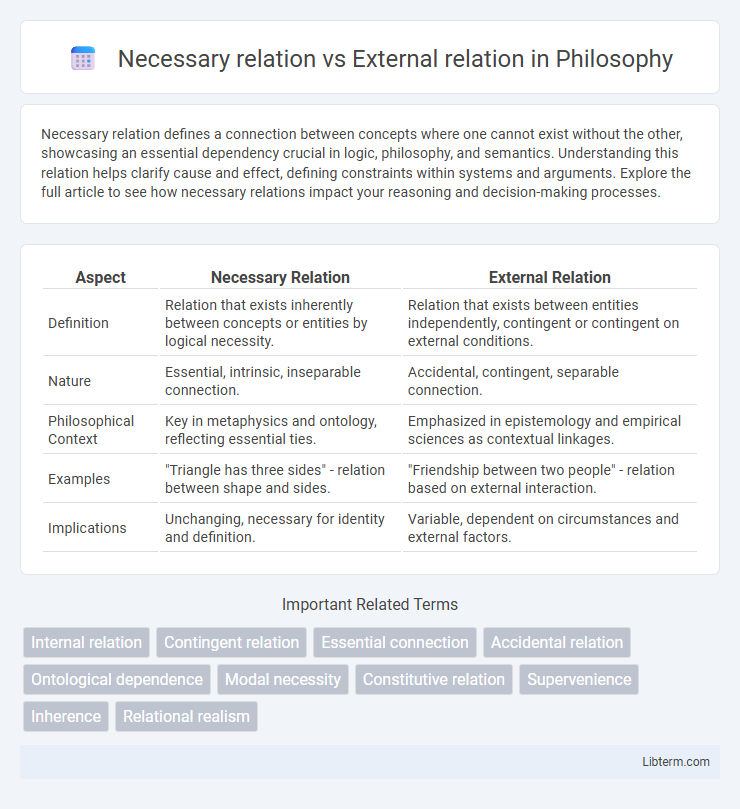Necessary relation defines a connection between concepts where one cannot exist without the other, showcasing an essential dependency crucial in logic, philosophy, and semantics. Understanding this relation helps clarify cause and effect, defining constraints within systems and arguments. Explore the full article to see how necessary relations impact your reasoning and decision-making processes.
Table of Comparison
| Aspect | Necessary Relation | External Relation |
|---|---|---|
| Definition | Relation that exists inherently between concepts or entities by logical necessity. | Relation that exists between entities independently, contingent or contingent on external conditions. |
| Nature | Essential, intrinsic, inseparable connection. | Accidental, contingent, separable connection. |
| Philosophical Context | Key in metaphysics and ontology, reflecting essential ties. | Emphasized in epistemology and empirical sciences as contextual linkages. |
| Examples | "Triangle has three sides" - relation between shape and sides. | "Friendship between two people" - relation based on external interaction. |
| Implications | Unchanging, necessary for identity and definition. | Variable, dependent on circumstances and external factors. |
Defining Necessary and External Relations
Necessary relations are intrinsic connections between entities that exist due to their essential properties, ensuring one entity cannot exist without the other in a specific context. External relations, by contrast, are connections that arise from how entities are positioned or interact externally but do not depend on their intrinsic nature. Understanding these distinctions is crucial in ontology and metaphysics for accurately modeling dependencies and interactions between entities.
Philosophical Origins of Relation Theory
Necessary relations are intrinsic connections that exist due to the inherent nature or definition of the entities involved, rooted in metaphysical principles emphasized by philosophers like Leibniz. External relations, conversely, are contingent links between distinct, independent entities, a concept explored by John Stuart Mill and later analytic philosophers. The philosophical origins of relation theory trace back to Aristotle's distinction between essential and accidental properties, evolving through debates in scholastic philosophy to contemporary analytic discussions on the ontological status of relations.
Characteristics of Necessary Relations
Necessary relations are characterized by their inherent, non-contingent connection between entities or concepts, meaning these relations hold true in all possible worlds without exception. They exhibit a logical or metaphysical necessity, such as the relation between a geometric shape and its properties or mathematical truths like "all bachelors are unmarried." Unlike external relations, necessary relations do not depend on external circumstances or empirical facts, ensuring their universality and stability across different contexts.
Features of External Relations
External relations in philosophy are characterized by their dependence on the intrinsic nature of distinct entities, where the relation itself cannot be reduced to internal properties or inconsistent with the individuality of the related entities. These relations are non-essential, meaning they do not define an entity's identity but influence its interaction with other entities in the external world. Features of external relations include their contingency, relational directionality, and the capability to vary without altering the fundamental essence of the related entities.
Key Differences Between Necessary and External Relations
Necessary relations involve connections that exist inherently between concepts or entities, such as logical dependencies that must hold true in all possible circumstances. External relations, by contrast, depend on contingent, empirical factors and are not essential to the entities themselves but arise from their interaction with the environment or context. Key differences lie in necessity versus contingency, with necessary relations being essential and invariant, while external relations are variable and context-dependent.
The Role of Context in Determining Relation Types
Necessary relations depend on intrinsic properties of entities, remaining constant across varying contexts, while external relations arise from contextual or environmental factors that influence how entities interact or relate. The role of context is crucial in distinguishing these relation types, as shifts in situational or temporal conditions can transform an external relation, but do not affect necessary relations. Understanding this distinction aids in accurate modeling of semantic networks and knowledge representation systems.
Examples of Necessary vs External Relations in Philosophy
Necessary relations in philosophy exemplify connections that hold true in all possible worlds, such as the relation between a triangle and its three angles summing to 180 degrees. External relations depend on contingent facts and external entities, like the spatial distance between two cities, which can vary without affecting their individual identities. Understanding the distinction clarifies metaphysical debates on whether relations are inherent to objects or arise from their external context.
Implications for Metaphysics and Ontology
Necessary relations are those that exist by virtue of the essential nature of the entities involved, often reflecting inherent or logical connections crucial for metaphysical frameworks. External relations, conversely, depend on contingent features or external conditions, challenging traditional ontologies by emphasizing relational properties that are not grounded in the essence of entities. The distinction impacts metaphysics by influencing debates on entity independence, identity, and the structure of reality, thereby shaping ontological categories and the understanding of causal and dependence relations.
Debates and Criticisms in Relation Theory
Debates in relation theory often focus on whether necessary relations, which hold by logical necessity, truly differ from external relations that depend on the distinct existence of related entities. Critics argue that necessary relations blur into external relations because the existence conditions of relata challenge strict necessity, questioning if any relation can be wholly independent from its terms. The controversy intensifies around metaphysical implications, with some philosophers defending internalism by asserting inherent connections between relata, while others uphold externalism, emphasizing contingent, context-dependent links.
Contemporary Perspectives on Relations
Necessary relations exist inherently and are essential to the identity of the related entities, such as mathematical truths or logical connections, while external relations depend on contingent features outside the entities themselves. Contemporary perspectives emphasize metaphysical debates about whether all relations are internal and necessary or if external relations possess ontological independence, influencing fields like analytic metaphysics and philosophy of science. This discourse impacts how relational properties shape objects and events, affecting concepts of causality, identity, and structural realism in modern philosophical inquiry.
Necessary relation Infographic

 libterm.com
libterm.com